Michigan chestnut update—June 10, 2014
Rose chafer has arrived in orchards and are easily visible feeding on foliage. Growers should carefully weigh the pros and cons of treatment. Caterpillars are feeding on leaves and potato leafhopper has been reported, though not yet observed on chestnut.

So far this season, the Benton Harbor Enviro-weather station has accumulated 567 growing degree days (GDD) 50 with 0.8 inches of rain over the past week, the Clarksville Enviro-weather station has recorded 518 GDD50 and 0.67 inches of rain this past week, and the Northwest Michigan Horticultural Research Center accumulated 394 GDD50 with no rain over the last week. Chestnuts in northern Michigan have catkins just beginning to emerge and most production areas could use some substantial rainfall in the coming week.
Rose chafers have been reported in the southern portion of the state. Rose chafers are considered a generalist pest and affect many crops, particularly those found on or near sandy soils or grassy areas. The adult beetles feed heavily on foliage and blossom parts of numerous horticultural crops in Michigan and can cause significant damage to chestnut orchards. Rose chafers can be particularly damaging on young trees with limited leaf area. Like Japanese beetles, rose chafers skeletonize the chestnut leaves, but tend to consume larger pockets of tissue with damage similar to caterpillar feeding than the fine lace-like leaf that results from Japanese beetle feeding.
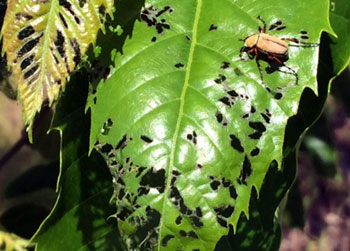
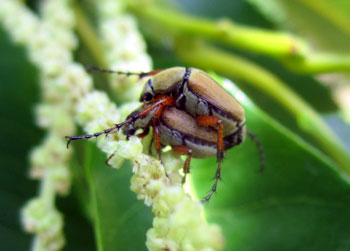
Left, Rose chafer feeding on chestnut. Right, Rose chafer mating on chestnut catkin. Photo credits: Mario Manujano, MSU (left) and Erin Lizotte, MSU Extension (right)
The rose chafer is a light tan beetle with a darker brown head and long legs, and is about 12 millimeters long. There is one generation per year. Adults emerge from the ground during late May or June and live for three to four weeks. Females lay groups of eggs just below the surface in grassy areas of sandy, well-drained soils. The larvae, or grubs, spend the winter underground, move up in the soil to feed on grass roots and then pupate in the spring. A few weeks later, they emerge from the soil and disperse by flight. Male beetles are attracted to females and congregate on plants to mate and feed.
They are often found in mating pairs and fly during daylight hours. Visual observation while walking a transect is the best method for locating them. Because of their aggregating behavior, they tend to be found in larger groups and are typically relatively easy to spot. There are no established treatment thresholds or data on how much damage a healthy chestnut tree can sustain from rose chafer, but growers should consider that well-established and vigorous orchards will likely not require complete control. Younger orchards with limited leaf area will need to be managed more aggressively.
Managing rose chafers can be a frustrating endeavor as they can reinfest from surrounding areas quickly. This reinfestsation is often misinterpreted as an insecticide failure, but efficacy trials have shown that a number of insecticides remain effective treatment options. Carbamate, organophosphate, pyrethroid and neonicotinoid insecticides all have good activity against rose chafers and can provide some control. Organic options including azadirachtin products and surround are marginally effective. Growers choosing to use kaolin clay should remember that good coverage is key and those considering pyrethroids or neonicotinoids should be aware that these products may potentially increase pest mite populations. For a list of the chemicals containing these active ingredients, refer to the Pesticides Registered for Edible Chestnuts, 2014 reference.
Growers should be on the lookout for potato leafhoppers as we can expect them to arrive in orchards any time. Like many plants, chestnuts are sensitive to the saliva of potato leafhoppers that is injected by the insect while feeding. Damage to leaf tissue can cause reduced photosynthesis, which can impact production and quality and damage the tree.
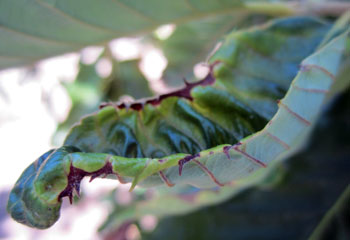
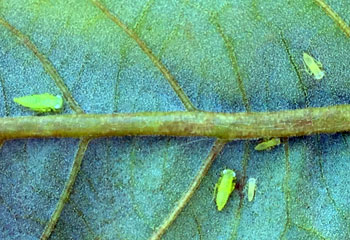
Left, Leaf cupping on chestnut caused by potato leafhopper damage. Right, Various nymphal stages of potato leafhopper along the mid-vein on the underside of a chestnut leaf. Photo credits: Erin Lizotte, MSU Extension (left) and Mario Mandujano (right), MSU
At this point in the season, potato leafhopper scouting should be performed following storm systems originating in the southern United States. Early detection is important to prevent injury. For every acre of orchard, growers should select five trees to examine and inspect the leaves on three shoots per tree, a total of 15 shoots per acre. The easiest way to observe potato leafhoppers is by flipping the shoots or leaves over and looking for adults and nymphs on the underside of leaves. Pay special attention to succulent new leaves on the terminals of branches. Growers may also hang yellow sticky traps in the orchard to catch potato leafhopper. Be sure to hang traps on both the edge and interior of the block. For more information on how to identify potato leafhoppers and symptoms of damage, as well as management recommendations, please refer to the Michigan State University Extension article, “Potato leafhopper management in chestnuts”.
Additionally, obliquebanded leafroller larvae (0.25-1 inches in length) and hornworms were also observed feeding on leaves in area orchards. These pests are not considered to be of economic significance.

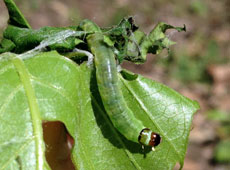
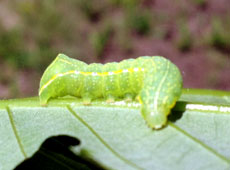
Left, Chestnut leaf tip rolled under by an obliquebanded leafroller. Middle, Obliquebanded leafroller larvae. Right, Hornworm feeding on chestnut leaves. Photo credits: Erin Lizotte, MSU Extension



 Print
Print Email
Email
